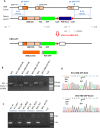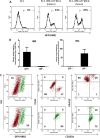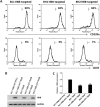A Universal Approach to Correct Various HBB Gene Mutations in Human Stem Cells for Gene Therapy of Beta-Thalassemia and Sickle Cell Disease
- PMID: 29164808
- PMCID: PMC5746148
- DOI: 10.1002/sctm.17-0066
A Universal Approach to Correct Various HBB Gene Mutations in Human Stem Cells for Gene Therapy of Beta-Thalassemia and Sickle Cell Disease
Abstract
Beta-thalassemia is one of the most common recessive genetic diseases, caused by mutations in the HBB gene. Over 200 different types of mutations in the HBB gene containing three exons have been identified in patients with β-thalassemia (β-thal) whereas a homozygous mutation in exon 1 causes sickle cell disease (SCD). Novel therapeutic strategies to permanently correct the HBB mutation in stem cells that are able to expand and differentiate into erythrocytes producing corrected HBB proteins are highly desirable. Genome editing aided by CRISPR/Cas9 and other site-specific engineered nucleases offers promise to precisely correct a genetic mutation in the native genome without alterations in other parts of the human genome. Although making a sequence-specific nuclease to enhance correction of a specific HBB mutation by homology-directed repair (HDR) is becoming straightforward, targeting various HBB mutations of β-thal is still challenging because individual guide RNA as well as a donor DNA template for HDR of each type of HBB gene mutation have to be selected and validated. Using human induced pluripotent stem cells (iPSCs) from two β-thal patients with different HBB gene mutations, we devised and tested a universal strategy to achieve targeted insertion of the HBB cDNA in exon 1 of HBB gene using Cas9 and two validated guide RNAs. We observed that HBB protein production was restored in erythrocytes derived from iPSCs of two patients. This strategy of restoring functional HBB gene expression will be able to correct most types of HBB gene mutations in β-thal and SCD. Stem Cells Translational Medicine 2018;7:87-97.
Keywords: Beta-thalassemia; CRISPR/Cas9; Gene editing; Gene therapy; Hemoglobinopathies; Stem cells.
© 2017 The Authors Stem Cells Translational Medicine published by Wiley Periodicals, Inc. on behalf of AlphaMed Press.
Figures





Similar articles
-
Improved hematopoietic differentiation efficiency of gene-corrected beta-thalassemia induced pluripotent stem cells by CRISPR/Cas9 system.Stem Cells Dev. 2015 May 1;24(9):1053-65. doi: 10.1089/scd.2014.0347. Epub 2015 Feb 5. Stem Cells Dev. 2015. PMID: 25517294
-
The Combination of CRISPR/Cas9 and iPSC Technologies in the Gene Therapy of Human β-thalassemia in Mice.Sci Rep. 2016 Sep 1;6:32463. doi: 10.1038/srep32463. Sci Rep. 2016. PMID: 27581487 Free PMC article.
-
Production of Gene-Corrected Adult Beta Globin Protein in Human Erythrocytes Differentiated from Patient iPSCs After Genome Editing of the Sickle Point Mutation.Stem Cells. 2015 May;33(5):1470-9. doi: 10.1002/stem.1969. Stem Cells. 2015. PMID: 25702619 Free PMC article.
-
CRISPR/Cas9 system and its applications in human hematopoietic cells.Blood Cells Mol Dis. 2016 Nov;62:6-12. doi: 10.1016/j.bcmd.2016.09.003. Epub 2016 Oct 2. Blood Cells Mol Dis. 2016. PMID: 27736664 Review.
-
Gene Therapy for β-Hemoglobinopathies.Mol Ther. 2017 May 3;25(5):1142-1154. doi: 10.1016/j.ymthe.2017.03.024. Epub 2017 Apr 1. Mol Ther. 2017. PMID: 28377044 Free PMC article. Review.
Cited by
-
Recent Updates on Induced Pluripotent Stem Cells in Hematological Disorders.Stem Cells Int. 2019 May 2;2019:5171032. doi: 10.1155/2019/5171032. eCollection 2019. Stem Cells Int. 2019. PMID: 31191673 Free PMC article. Review.
-
Gene Therapy for Beta-Hemoglobinopathies: Milestones, New Therapies and Challenges.Mol Diagn Ther. 2019 Apr;23(2):173-186. doi: 10.1007/s40291-019-00383-4. Mol Diagn Ther. 2019. PMID: 30701409 Review.
-
Evaluation of 2D and 3D Erythroid Differentiation Protocols Using Sickle Cell Disease and Healthy Donor Induced Pluripotent Stem Cells.Cells. 2023 Apr 10;12(8):1121. doi: 10.3390/cells12081121. Cells. 2023. PMID: 37190030 Free PMC article.
-
Sharpening the Molecular Scissors: Advances in Gene-Editing Technology.iScience. 2020 Jan 24;23(1):100789. doi: 10.1016/j.isci.2019.100789. Epub 2019 Dec 19. iScience. 2020. PMID: 31901636 Free PMC article. Review.
-
β-Hemoglobinopathies: The Test Bench for Genome Editing-Based Therapeutic Strategies.Front Genome Ed. 2020 Dec 3;2:571239. doi: 10.3389/fgeed.2020.571239. eCollection 2020. Front Genome Ed. 2020. PMID: 34713219 Free PMC article. Review.
References
Publication types
MeSH terms
Substances
Grants and funding
LinkOut - more resources
Full Text Sources
Other Literature Sources
Medical
Research Materials

